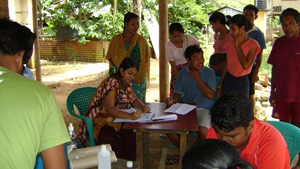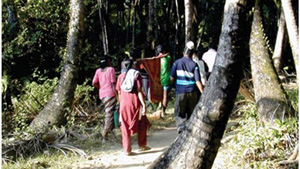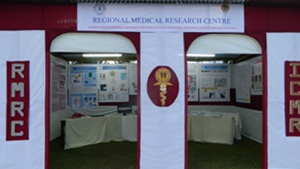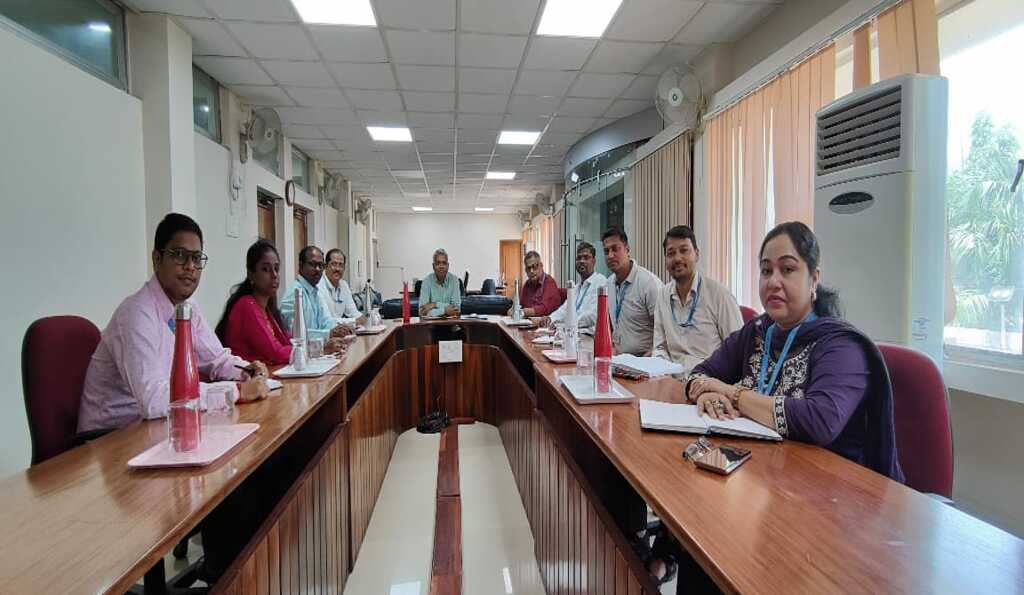
Hepatitis-B Survey in Car Nicobar

Transferring a malaria case from temporaray camp to BJR

Stall of RMRC at Bharat Nirman
Post-tsunami relief in Car Nicobar
An earthquake hit Andaman & Nicobar Islands on 26 December 2004, which triggered a series of tsunami/tidal wave hits. Several buildings were damaged in the earthquake in Andaman Islands. Low-lying areas were inundated resulting in the death of several people and rendering homeless to many others of the Andaman Islands. The devastation was at a larger scale in the Nicobar group of Islands. Almost the whole of Car Nicobar was flooded and a large number of houses and buildings were destroyed. Several thousand people were feared missing. The influx of water could potentially increase the transmission of vector borne diseases such as malaria and dengue fever. The earthquake followed by tsunami/tidal waves had led to environmental disturbance of the kind that has created numerous depressions of the terrain and resultant huge influx of seawater has created a vast stretch of stagnant water bodies. Against this back drop, the Local administration requested the Centre to assist the health authorities in the execution of relief measures, help in planning measures for preventing epidemics and to investigate impending outbreaks and to assess the risk of vector borne diseases.
The team from the Centre was assigned the duty of rendering health care in the camps inhabited by the people of three villages viz., Sawai, Teetop and Arong. As a part of the RMRC team, was involved in detection of malaria outbreak at the Sawai camps of Car Nicobar. Other activities included Rapid entomological assessment in and around the camps. An. sundaicus was found to be prevalent in almost all the camps. All the fever cases were given radical treatment. Vector control measures in the form of larvicidal activities, DDT spraying; impregnated bed-net distribution and fever surveillance for malaria were undertaken in collaboration with the local health authorities. During our period of stay on this island regular active case detection and assessment /monitoring of Anopheline breeding status was undertaken.
Assessment of impregnated bed net usage and its impact on malaria
There was about 5-6 fold increase in malaria cases during the months following tsunami in 2004. Under National Vector Borne Diseases Control Programme (NVBDCP, GOI), in order to control post tsunami malaria upsurges, distributed insecticide impregnated bed nets. Assessment of impregnated bed net usage and its impact on malaria incidence was undertaken by the Centre. Pre-tested structured individual questionnaire was administered to assess the usage of nets, net ownership, age and sex specific coverage among different age groups. Qualitative data was obtained through Focus Group Discussions among the tribal community. Over 90% of the population was observed to sleep under net. No significant difference was observed between age groups concerning the habit of sleeping under net. The habit of sleeping under the net was significantly lower among all the age groups pre- tsunami, with an overall proportion of 6.6% of the population sleeping under the net as compared to 91.8% post-tsunami. Temporal analysis of malaria data indicated a declining trend. Insecticide impregnated bed net distribution programme had an impact on the incidence of malaria in Car Nicobar.
Awareness Campaigns
During the Chikungunya, epidemic in August -December 2006, organized awareness about the disease, personal protection measures and anti-vector measures to be adopted at community level. These activities were highlighted during the health awareness campaign for control of vectors in the areas affected recently by Dengue and Chikungunya fever in Bambooflat, South Andaman.





